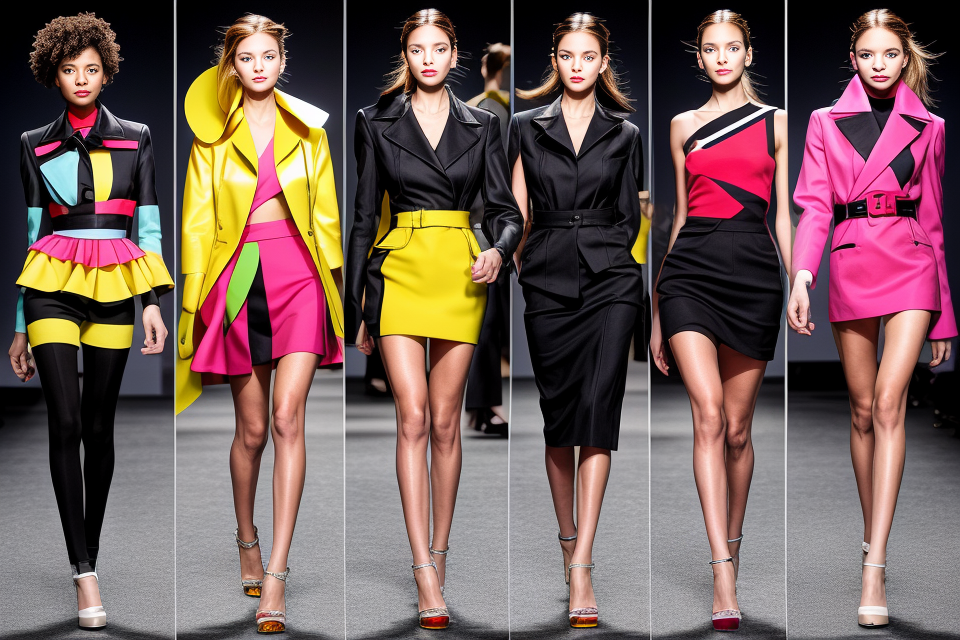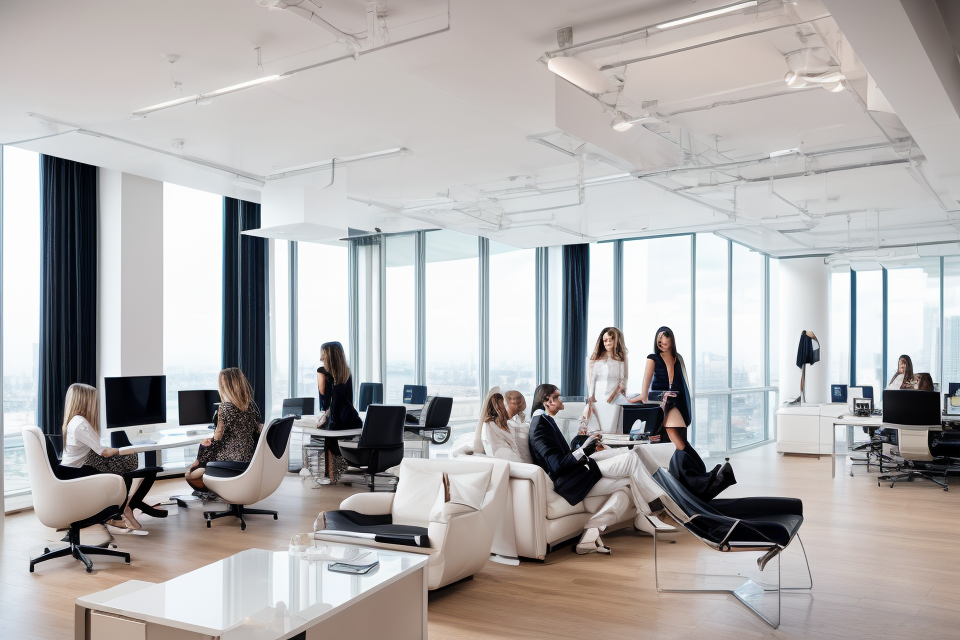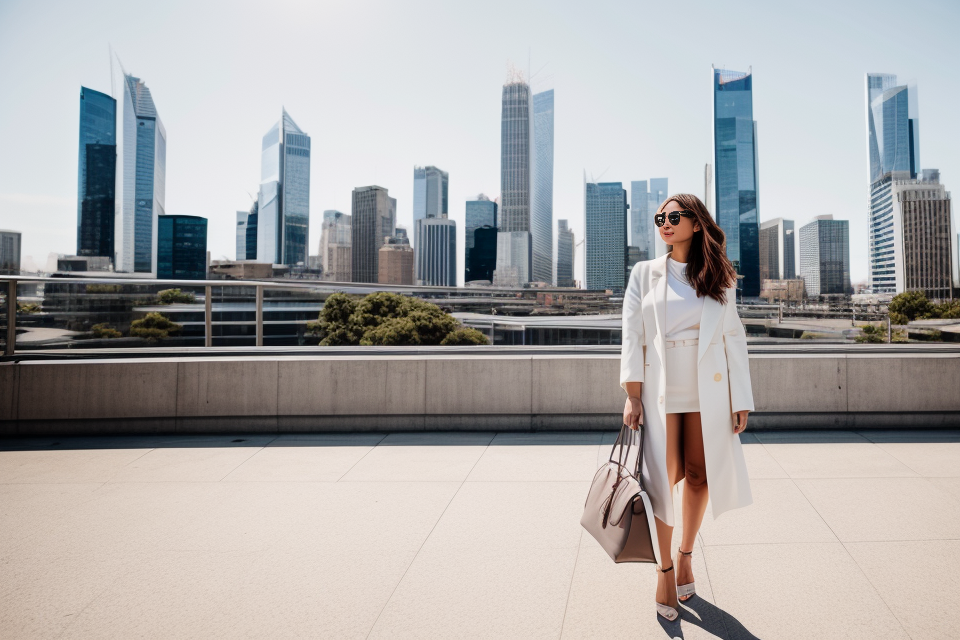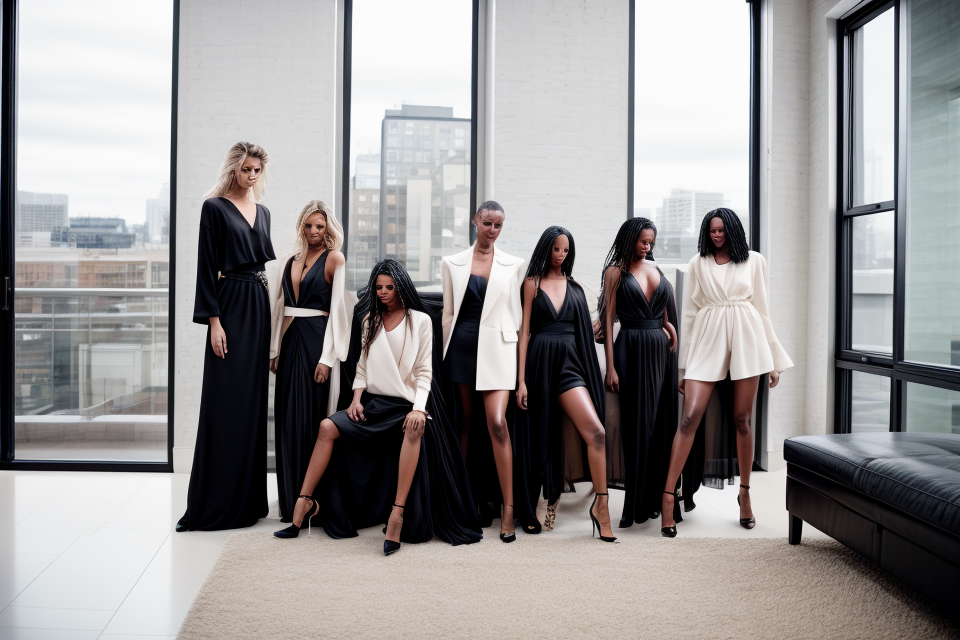
Fashion trends are constantly changing and evolving, and it can be fascinating to explore the different stages that a trend goes through before it becomes a staple in the fashion world. From emergence to decline, there are five distinct stages that a fashion trend can go through. Understanding these stages can help us to better understand the fashion industry and how trends come and go. In this article, we will explore the five stages of fashion trends and how they impact the world of fashion.
The 5 stages of fashion trends are: 1) Introduction: The trend first appears on the fashion scene, often introduced by fashion influencers or designers. 2) Hype: The trend gains popularity and becomes a must-have item for many fashion enthusiasts. 3) Plateau: The trend reaches its peak and becomes a staple in the fashion world. 4) Decline: The trend begins to lose its popularity and becomes less relevant to consumers. 5) Absorption: The trend becomes a classic and is integrated into the fashion canon, becoming a staple in the wardrobes of many.
Understanding Fashion Trends
The Definition of Fashion Trends
The constantly changing nature of fashion
Fashion trends refer to the prevailing styles and tastes in clothing, accessories, and other fashion-related items that are popular at a particular time. These trends are constantly changing, with new styles emerging and old ones falling out of favor. The fashion industry is known for its fast-paced nature, with designers and retailers always looking for the next big thing to keep up with consumer demand.
The influence of fashion trends on society
Fashion trends have a significant impact on society, influencing everything from the way people dress to the way they perceive themselves. They can reflect social, economic, and cultural changes, and can even serve as a form of social and cultural expression. In addition, fashion trends can impact the economy, with the fashion industry being a significant contributor to global economic growth.
As fashion trends continue to evolve, it is important for individuals and businesses to stay up-to-date with the latest styles and tendencies. This can help them to remain relevant and competitive in an ever-changing market. By understanding the definition of fashion trends and their impact on society, individuals and businesses can make informed decisions about their fashion choices and strategies.
The Drivers of Fashion Trends
Fashion trends are driven by a variety of factors that shape consumer preferences and dictate the direction of the fashion industry. These drivers are constantly evolving and can vary from season to season. Understanding the drivers of fashion trends is essential for fashion designers, retailers, and consumers alike.
The role of celebrities and influencers
Celebrities and influencers play a significant role in shaping fashion trends. They are often seen as style icons and trendsetters, and their fashion choices can have a profound impact on consumer preferences. Celebrities and influencers can influence fashion trends through their appearances on red carpets, in music videos, and on social media. They can also promote fashion brands and designers, which can help to boost their popularity and sales.
Moreover, celebrities and influencers often have access to exclusive fashion pieces and can showcase new trends and styles to their followers. This can create a buzz around a particular fashion trend and encourage consumers to adopt it. However, it is important to note that not all fashion trends promoted by celebrities and influencers will become mainstream.
The impact of social media on fashion trends
Social media has had a profound impact on fashion trends. Platforms such as Instagram, TikTok, and Twitter have given rise to a new generation of influencers who can reach a massive audience with their fashion choices. Social media has also made it easier for consumers to discover new trends and styles, as well as to share their own fashion choices with others.
Furthermore, social media has enabled fashion brands and designers to connect directly with consumers, which has helped to democratize the fashion industry. Brands can use social media to showcase their collections, collaborate with influencers, and engage with consumers in real-time. This has helped to create a more dynamic and interactive fashion industry, where trends can emerge and evolve more quickly than ever before.
Overall, the drivers of fashion trends are complex and multifaceted. They are influenced by a variety of factors, including celebrity and influencer culture, social media, and broader cultural and societal trends. Understanding these drivers is essential for anyone interested in the fashion industry, as it can help to predict and influence future trends.
The Importance of Fashion Trends
The role of fashion trends in personal expression
Fashion trends play a crucial role in personal expression as they allow individuals to communicate their unique style and personality to the world. By following or embracing specific trends, people can showcase their individuality and creativity, distinguishing themselves from others. In addition, fashion trends provide a platform for self-expression, enabling individuals to experiment with different styles and explore their own personal tastes.
The impact of fashion trends on the economy
Fashion trends have a significant impact on the economy, as they drive consumer spending and influence the production and distribution of clothing and accessories. As trends gain popularity, demand for associated products increases, leading to the growth of fashion industries and the creation of new job opportunities. Furthermore, fashion trends influence the innovation and development of new materials, designs, and technologies, fostering the growth of the fashion industry as a whole. In turn, the fashion industry contributes to the overall economic growth and development of a region or country.
The 5 Stages of Fashion Trends
Stage 2: Growth
The second stage of fashion trends is growth, where the trend gains momentum and becomes more mainstream.
The trend gains momentum
During this stage, the trend starts to gain momentum as more people start to adopt it. The trend may have been introduced by a few fashion-forward individuals, but as more people start to see it, it becomes more popular. This can be driven by various factors, such as social media influencers, celebrities, or even just word-of-mouth. As the trend gains momentum, it starts to become more visible and noticeable, and people start to take notice.
The trend becomes more mainstream
As the trend gains momentum, it starts to become more mainstream. This means that it is no longer just popular among a select few, but rather it is being adopted by a wider audience. This can be seen in the fashion industry, where designers start to incorporate the trend into their collections, and retailers start to offer it to a wider audience. This can also be seen in the media, where the trend starts to be featured more prominently in fashion magazines, blogs, and other forms of media.
During this stage, the trend is still relatively new and fresh, and it may not have yet reached its peak. However, it is starting to become more accepted and adopted by a wider audience, and it is becoming more mainstream. This stage is an important one in the lifecycle of a fashion trend, as it marks the transition from a niche trend to a more mainstream one.
Stage 3: Peak
The trend reaches its height
At the peak of a fashion trend, the style has reached its highest level of popularity and acceptance. This stage is characterized by the widespread adoption of the trend across various fashion platforms, including runways, magazines, and social media. At this point, the trend has been fully embraced by the mainstream fashion industry and has become a staple in the fashion world.
The trend becomes ubiquitous
During the peak stage of a fashion trend, the style can be found everywhere, from high-end fashion stores to fast fashion retailers. The trend has been adopted by fashion influencers, celebrities, and even the general public, making it a defining feature of the current fashion landscape. At this stage, the trend has transcended its original source and has become a part of the collective fashion consciousness.
As the trend reaches its peak, it may also begin to be parodied or subverted by fashion designers and influencers, who may use it as a starting point for their own creative work. This can lead to the emergence of new sub-trends or variations on the original theme, as designers and consumers alike seek to put their own unique spin on the trend.
Overall, the peak stage of a fashion trend is a time of excitement and creativity, as designers and consumers alike embrace the trend and push the boundaries of fashionable expression.
Stage 4: Decline
The trend starts to fade
- The trend begins to lose its appeal and popularity
- It gradually becomes less relevant and less talked about
- The number of people wearing or using the trend decreases
- It becomes less common to see the trend in public places
The trend becomes less relevant
- The trend no longer fits in with current fashion or cultural trends
- It may still have some die-hard fans, but it is no longer considered cool or trendy
- The trend may still be available for purchase, but it is not as popular or sought after as it once was
- It may be difficult to find the trend in stores or online, as retailers may stop carrying it
Stage 5: Extinction
The trend is no longer relevant
The final stage of a fashion trend is its extinction. At this point, the trend has lost its relevance and appeal to consumers. This can be due to a variety of factors, such as changing social and cultural norms, new technologies, or shifts in consumer preferences. When a trend reaches this stage, it is no longer profitable for fashion brands to continue producing and promoting it.
The trend is replaced by a new trend
As the trend fades away, a new trend begins to emerge. This can be driven by changes in the fashion industry, such as the rise of new designers or the influence of celebrities and influencers. The new trend may incorporate elements of previous trends, but it will have its own unique style and appeal. Brands will begin to promote the new trend, and consumers will start to adopt it, leading to its growth and eventual dominance in the fashion industry.
The ever-changing nature of fashion trends
Fashion trends are a dynamic and ever-changing aspect of the fashion industry. They are constantly evolving and transforming, influenced by various factors such as cultural shifts, social media, and celebrity endorsements. These trends can range from a specific color or pattern to a particular style or silhouette.
One reason for the constant change in fashion trends is the fast-paced nature of the industry. Designers and brands are constantly looking for new and innovative ways to stand out and capture the attention of consumers. This can lead to a rapid cycle of trends, with new styles and designs emerging frequently.
Another factor contributing to the ever-changing nature of fashion trends is the influence of social media. With the rise of platforms like Instagram and TikTok, fashion trends can spread quickly and widely, with individuals around the world able to share their own styles and influences. This can lead to a more democratic and diverse range of trends, as well as a faster turnover of styles.
In addition, the fashion industry is highly competitive, with brands and designers constantly seeking to differentiate themselves and appeal to consumers. This can lead to a focus on short-term trends and a quicker turnover of styles, rather than a long-term focus on sustainable and timeless fashion.
Overall, the ever-changing nature of fashion trends is a result of the fast-paced, competitive, and innovative nature of the fashion industry. It is driven by a range of factors, including cultural shifts, social media, and the desire for brands and designers to stand out and appeal to consumers.
The importance of staying current with fashion trends
Fashion trends are constantly evolving, and it’s important for individuals and businesses alike to stay current with these changes. The fashion industry is highly competitive, and being ahead of the curve can give a company or individual a significant advantage.
One reason to stay current with fashion trends is to appeal to customers. Consumers are always looking for the latest styles and designs, and by staying up-to-date with the latest trends, businesses can meet this demand and attract new customers. Additionally, by staying current with fashion trends, businesses can also retain existing customers by keeping them interested and engaged.
Another reason to stay current with fashion trends is to establish a brand identity. Fashion trends often reflect the cultural and social norms of a particular time period, and by aligning with these trends, businesses can establish a unique brand identity that resonates with their target audience. This can help businesses stand out in a crowded market and increase brand recognition.
Additionally, staying current with fashion trends can also help businesses stay ahead of the competition. By being the first to introduce new styles or designs, businesses can gain a competitive edge and establish themselves as industry leaders.
Furthermore, fashion trends can also serve as a source of inspiration for businesses. By keeping up with the latest trends, businesses can gain insight into new materials, techniques, and designs that they can incorporate into their own products. This can lead to innovation and the development of new and unique products that set businesses apart from their competitors.
Overall, staying current with fashion trends is crucial for businesses and individuals alike. It can help attract and retain customers, establish a unique brand identity, stay ahead of the competition, and inspire innovation. By staying up-to-date with the latest trends, businesses can position themselves for success in the ever-changing fashion industry.
The potential impact of future fashion trends on society
The impact of fashion trends on society is a complex and multifaceted issue. Fashion trends not only reflect cultural values and social norms but also shape them. As such, the potential impact of future fashion trends on society is significant and far-reaching. Here are some of the ways in which future fashion trends may affect society:
1. Economic Impact
Fashion trends have a significant impact on the economy. The fashion industry is a major contributor to the global economy, providing employment for millions of people worldwide. Future fashion trends may drive innovation and growth in the industry, creating new job opportunities and stimulating economic development. On the other hand, the fast-paced and constantly changing nature of fashion trends can also lead to job instability and economic uncertainty.
2. Cultural Impact
Fashion trends are often a reflection of cultural values and social norms. As such, future fashion trends may have a significant impact on cultural identity and expression. For example, fashion trends may influence the way people dress, behave, and interact with one another. In turn, these changes in fashion may lead to shifts in cultural attitudes and beliefs.
3. Environmental Impact
The fashion industry is a significant contributor to environmental degradation, with a high carbon footprint and heavy reliance on non-renewable resources. Future fashion trends may therefore have a significant impact on the environment. For example, the shift towards sustainable and eco-friendly fashion may reduce the industry’s environmental impact and promote more sustainable practices. On the other hand, the continued pursuit of fast fashion and consumerism may exacerbate environmental problems and contribute to climate change.
4. Social Impact
Fashion trends can also have a significant impact on social issues such as gender, race, and class. For example, future fashion trends may challenge traditional gender norms and promote more inclusive and diverse representations of beauty. On the other hand, fashion trends may also perpetuate harmful stereotypes and reinforce social hierarchies.
5. Psychological Impact
Finally, fashion trends can also have a significant impact on individual psychology and self-esteem. For example, the pressure to conform to fashion trends and maintain a certain appearance can lead to anxiety and low self-esteem. On the other hand, the freedom to express oneself through fashion may promote self-confidence and personal empowerment.
In conclusion, the potential impact of future fashion trends on society is vast and varied. While there may be positive benefits to economic growth, cultural expression, environmental sustainability, and individual empowerment, there are also potential negative consequences such as economic instability, cultural homogenization, environmental degradation, and psychological distress. It is therefore important to consider the broader social and cultural implications of future fashion trends and work towards a more sustainable and inclusive fashion industry.
FAQs
1. What are the 5 stages of fashion trends?
The 5 stages of fashion trends are:
1. Dormant Stage: In this stage, the trend is just emerging and is not yet recognized by the general public. It is often seen in small fashion circles or on independent designers.
2. Fluent Stage: At this stage, the trend has become more visible and is gaining popularity. It can be seen in boutique stores, small fashion magazines, and sometimes on social media influencers.
3. Popular Stage: This is the stage where the trend becomes mainstream and is widely accepted by the general public. It can be seen in high-street stores, fashion magazines, and even on fashion icons and celebrities.
4. Saturation Stage: At this stage, the trend has become too popular and is over-saturated. It can be seen everywhere, and it loses its original appeal and exclusivity.
5. Obsolescence Stage: In this final stage, the trend is no longer relevant or fashionable. It is considered outdated and is often replaced by a new trend.
2. How long does each stage of fashion trends last?
The length of each stage of fashion trends can vary greatly. The dormant stage can last for several years, while the fluent stage can last for a few months. The popular stage can last for a year or two, while the saturation stage can last for a few months. The obsolescence stage can last for a few weeks or months.
3. How can I identify the current stage of a fashion trend?
To identify the current stage of a fashion trend, you can look at various sources such as fashion magazines, social media, and fashion blogs. You can also observe what is being worn on the streets and in stores. If a trend is just emerging, it may be seen in small fashion circles or on independent designers. If it is gaining popularity, it may be seen in boutique stores and small fashion magazines. If it is mainstream, it will be widely available in high-street stores and fashion magazines.
4. Can a fashion trend return to an earlier stage after passing through all five stages?
Yes, a fashion trend can return to an earlier stage after passing through all five stages. This is often referred to as a “trend revival.” For example, a trend that was popular in the 1980s may reappear in the dormant stage several years later, and then go through the five stages again before eventually becoming obsolete.
5. How can I stay ahead of fashion trends?
To stay ahead of fashion trends, you can follow fashion influencers and designers on social media, subscribe to fashion magazines, and attend fashion shows and events. You can also experiment with different styles and experiment with new trends. It’s important to remember that fashion is not just about following trends, but also about expressing your personal style and individuality.


